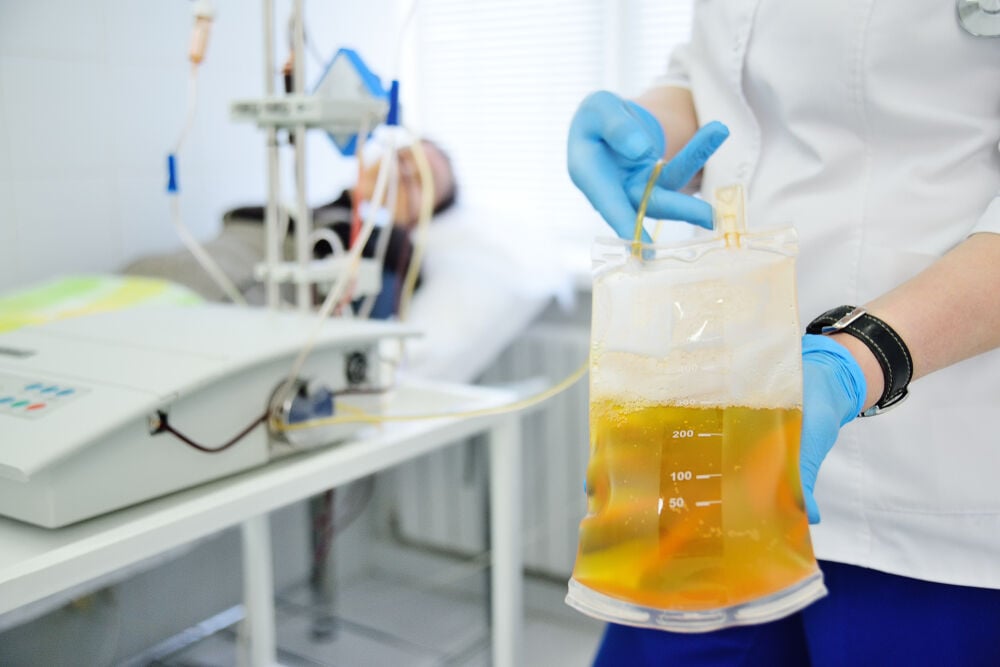Do you want to donate plasma, either to earn a little extra money or to help your community? Although it’s a fairly common practice, it’s a little more complicated than donating blood. If you’re thinking of doing this for the first time, you might be uncertain what to expect. Read on for our guide to frequently asked questions about the requirements for donating plasma and the process overall.
-
Tracking cycle
-
Getting pregnant
-
Pregnancy
-
Help Center
-
Flo for Partners
-
Anonymous Mode
-
Flo app reviews
-
Flo Premium New
-
Secret Chats New
-
Symptom Checker New
-
Your cycle
-
Health 360°
-
Getting pregnant
-
Pregnancy
-
Being a mom
-
LGBTQ+
-
Quizzes
-
Ovulation calculator
-
hCG calculator
-
Pregnancy test calculator
-
Menstrual cycle calculator
-
Period calculator
-
Implantation calculator
-
Pregnancy weeks to months calculator
-
Pregnancy due date calculator
-
IVF and FET due date calculator
-
Due date calculator by ultrasound
-
Medical Affairs
-
Science & Research
-
Pass It On Project New
-
Privacy Portal
-
Press Center
-
Flo Accuracy
-
Careers
-
Contact Us
Donating Plasma FAQ: Everything You Need to Know about Plasma Donation


Every piece of content at Flo Health adheres to the highest editorial standards for language, style, and medical accuracy. To learn what we do to deliver the best health and lifestyle insights to you, check out our content review principles.
Why donate plasma?
Plasma donation is different than donating whole blood. Plasma is the liquid part of the blood that contains the elements necessary for blood clotting. Donating it is a more complicated process than donating blood. The blood is drawn from your arm, the components are separated, and the plasma is put into a separate bag. Then, the remaining blood components are inserted back into your arm.
For many chronic diseases, plasma therapy is one of the primary treatments. For example, people with clotting disorders such as hemophilia or bleeding disorders may need scheduled plasma transfusions. Other uses for plasma include emergency medical treatment, such as for burn victims or those who have contracted rabies, and transfusions for dialysis patients or organ donation recipients.
Plasma is also used in labs to create medications to treat certain kinds of diseases, such as immune deficiency diseases and certain pulmonary illnesses like hereditary emphysema. The World Health Organization (WHO) considers plasma an essential part of medication.
What can disqualify you from donating plasma?
If you’re interested in donating plasma, requirements exist for a rigorous screening as part of the plasma donation process. Part of the reason that the screening process exists is to protect those receiving the donations, many of whom have compromised health. It also ensures that the donors themselves are in good enough physical health to avoid the side effects of donating plasma.
The requirements for donating plasma are fairly consistent. You must be at least 16 years old, weigh over 110 pounds, and have a valid ID. Do they drug test you before donating plasma? Not generally — people who take certain prescription drugs, show signs of injectable drug use, or are visibly intoxicated are not allowed to donate plasma.
Take a quiz
Find out what you can do with our Health Assistant
Part of the reason that the screening process exists is to protect those receiving the donations, many of whom have compromised health.
Certain health conditions also prevent you from donating, such as pregnancy or recent childbirth. If you’ve had dental work in the past 72 hours, you’ll be deferred. Also, if you’ve received the MMR vaccine or had chickenpox in the past month or taken antibiotics orally in the past 24–48 hours or by injection in the past 72 hours, you’re also deferred.
Ever having had viral hepatitis A, B, or C disqualifies a person from donating, as do certain chronic diseases like hemophilia or other bleeding disorders. People can’t donate if they have or had tuberculosis, heart disease (and currently taking medication for it), sickle cell anemia, certain types of cancer, or malaria (contracted in the past three years or travelled to an endemic area in the past year). People who are HIV positive or who may have placed themselves at risk for contracting the virus also cannot donate plasma.
What medications disqualify you from donating plasma? People who have taken Accutane, oral Retin-A, or finasteride in the past month can’t donate. Anyone who has ever taken etretinate is not allowed to donate plasma. People who are currently taking medication for treating TB or malaria also can’t donate. Finally, if you’ve gotten a body piercing or tattoo in the past 12 months, you’re ineligible. The only exception to the tattoo rule is if the tattoo is from a licensed facility in Louisiana, Texas, Alabama, or Mississippi, in which case there’s only a one-month wait.
Side effects of donating plasma
Donating plasma can have side effects that are typically minor, but if it’s your first time donating, you may wish to have a ride home, just in case. Bruising and nerve irritation are among the most common, usually around the injection site. It may have mild swelling, which can be treated with cold packs. Nerve irritation causes immediate, intense pain at the injection site and can cause shooting pain down the arm and into the hand. If this happens, alert the technician — they’ll immediately remove the needle. This should eliminate the stabbing pain, although some mild discomfort may remain for a day or two afterward.
More serious risks of donating plasma may be a drop in blood pressure, which can result in light-headedness or fainting. Some people experience this as a result of fear of needles or having blood drawn. Other possible side effects include sweating and paleness, weakness, sudden warmness, or nausea or vomiting. Dizziness and blurred or tunnel vision may also occur.
More serious risks of donating plasma may be a drop in blood pressure, which can result in light-headedness or fainting.
These symptoms may lead to fainting but can be minimized by reclining in the donation chair and elevating the feet while applying a cool compress. Luckily, the techs at plasma centers are trained to anticipate and treat this. However, if you vomit or faint, the donation process will be halted. On extremely rare occasions, a seizure due to a prolonged loss of consciousness may occur, although long-term effects of donating plasma are rare.
Citrate reaction may occur if you’re sensitive to the chemical citrate, which is added to the separated blood to prevent clotting. When the remnants of your donation are returned, you may experience tingling around your mouth, face, hands, or feet. More severe reactions include cramping of the hands or feet and sudden weakness. Muscle spasms, chills and shaking, nausea or vomiting, and numbness around the mouth may occur.
If a mild reaction occurs, the donation is typically paused, calcium may be given to you to eliminate these side effects of donating plasma. However, with a severe citrate reaction, the donation process is halted. You may need emergency attention.

Irregular cycle or heavy periods?
Find out how this can affect you before donating.
Is donating plasma painful?
Whether the process is painful for you depends on your pain threshold. For some people, donating feels no worse than a pinprick, while others may feel more pain. If the nurse misses the vein or you experience plasma donation side effects, it’s possible you’ll experience more pain, but overall, most people report nothing more than mild discomfort.
How to donate plasma

Expect the plasma donation process to take 1 to 2 hours. If it’s your first time at the donation center, the initial paperwork and health screening may take longer. Depending on how fast the blood draw occurs, the actual donation part takes roughly an hour.
To donate, make an appointment at a reputable plasma donation center. If you aren’t sure where to go, check with your doctor or a local hospital for recommendations. Currently, there are more than 700 licensed and certified plasma collection centers in the US and Europe Licensing means that your donation will be executed by a trained medical professional in a highly controlled, sterile environment.
How often can you donate plasma?
The US Food and Drug Administration allows up to 2 donations during a 7-day period, although you’re required to wait at least 48 hours between donations.
How much can you make donating plasma? Each center has its own standard compensation, although the average in the US is about $50 per donation.
What to eat before donating plasma
Drinking plenty of water and eating a balanced, healthy diet is always a good choice, but it’s even more important on the days leading up to plasma donation. Make sure to get a good night’s sleep before the day of your donation. Drink about 6 to 8 cups of water the day before and day of donating, and eat a protein- and iron-rich meal within 3 hours of donation.
High-protein foods include beans and legumes, beef, chicken, shrimp, cheese, eggs, milk, yogurt (especially Greek yogurt), and seeds and nuts. Broccoli, beef, beans, iron-enriched breakfast cereals, chicken, ham, dark leafy greens, raisins, and watermelon are all high in iron.
Avoid fatty foods like French fries and other fried foods, pizza, or sweets the day you donate, and don’t drink alcohol the night before. These can affect your blood tests and prevent you from donating.
Conclusion
Plasma donations help save lives and can put a little extra cash in your wallet. While many people experience very mild side effects, there are a few to consider, and you should consult with your doctor before your initial donation for their recommendation. Follow the proper health guidelines to ensure that you’re a good plasma donor candidate, and don’t worry if you’re turned away the first time. Many people can donate again after not being cleared the first time. Remember, your contribution can have a great impact on the health of others in your community.


Hey, I'm Anique
I started using Flo app to track my period and ovulation because we wanted to have a baby.


The Flo app helped me learn about my body and spot ovulation signs during our conception journey.


I vividly
remember the day
that we switched
Flo into
Pregnancy Mode — it was
such a special
moment.
Real stories, real results
Learn how the Flo app became an amazing cheerleader for us on our conception journey.




